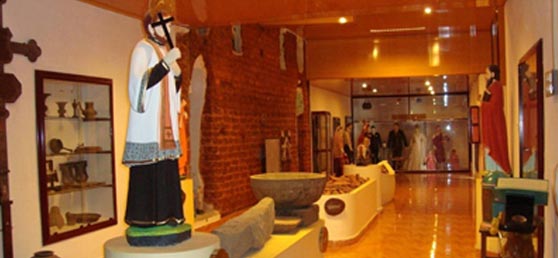
Sampaloor, by the side of the
Chalakudy River is known as the Goa of Kerala. Rightfully called so,
this place, like Goa witnessed the arrival of a series of clergy. This
comprised St. Francis Xavier, St. John Britto, Fr. Joseph Constantine
Buski (Veeramamunivar) and Arnos Pathiri. Among them, the first to
arrive at Sampaloor was St. Francis Xavier, who came via Marankuzhi, a
place located in Kodungalloor (former Muziris). His visits, as per
records, were in 1542, 1544, and 1548. At that time the Muziris
harbour (present day Kodungalloor) connected India to foreign
countries via the sea.
Sampaloor was an important center of
Jesuits during the time of the Portuguese. Some of the structures
still stand testimony to the works of the Jesuits in Sampaloor. They
include the St. Paul's Seminary, the St. Paul's Monastery and the St.
Paul's Press and a church dedicated to St. Francis Xavier. Gradually
San-paul-ur became Sampaloor. Half way though the 17th century St.
John Britto, an Italian missionary, came to Sampaloor and lived there
for nearly one year. He studied Tamil and Sanskrit and adopted an
Indian name - Swamy Arulananda. The altar of St. Francis Xavier's
church at which St. John Britto used to celebrate the holy mass is now
a protected historical monument.
Another member of the
clergy, who made his presence felt at Sampaloor after St. John Britto
was Arnos Pathiri, who studied at the St. Paul's Seminary and later
got ordained there. He made remarkable contributions to the Malayalam
literature through his book 'Puthen Pana.' Next to follow was Fr.
Joseph Constantine Buski (Veeramamunivar). He came to Sampaloor, while
serving in Madurai Mission and later lived there. Fr. Buski's final
resting place is also at Sampaloor.
The first printing in
Malayalam was done at the St. Paul's Press in Sampaloor, which was set
up by Jesuit Priests in 1663. The dictionary of 'Prinsa Pathiri,'
Tamil grammar of Dacosta Pathiri, and the books of Dinobili were printed
in this press. Sampaloor thus became a great centre for
language-nurturing in south India.
The arrival of the
clergymen to Sampaloor in the mid 16th century and the developments
that took place all later became part of the ecclesiastical history of
Kerala. Sampaloor also went through an unfortunate phase in the
course of its history, when it was devastated in an attack by Tippu
Sultan, who was fighting the British during the middle periods of the
18th century. Later, the church got reconstructed during the time of
Bernadian Bechinelly, who was the vicar apostolate of Varapuzha in
1862. The present church was blessed in 1979.
Historical museum of Sampaloor
When samaploor
was the centre of Jesuit Missionthere wereSt. Paul's seminary, St,
Paul's Press, St. Paul's Monastery, And St. Francis Xavier's Church
which were destroyed by Tippu the invader. the Cannon balls used
during the time of Tippu, holy vestments of the priests of the
Monastery, Tablets that describe the old liturgical order, instruments
used to make the hosts, Tabernacle of theold church, statues ofsaints
made of wood and metals, Lamps used for adoration, lamp-sticks, the
Cross made of metal belongs to 15Th century and ''Vazhuthayodukal" of
the same century are some of the attractions of this Museum.
Anglo-Indian Cultural museum
A sight of Anglo-Indian wedding ceremony, Anglo-Indian Traditional
dress for women and men such as Kabaya, Madirasi thuny, a collection
of coat, Suit, tie, bohatt, their traditional ornaments like
Cothigna, Arulikka mala, Pinnu mala, Wedding ring, and their
traditional foods are some of the sights inside this museum.
Address
St. Francis Xavier Church
Sampaloor
Palayamparambu P.O.
Pin 680 741
Ph. 0480 2719079
|
| Maritime Museum |
|
 |
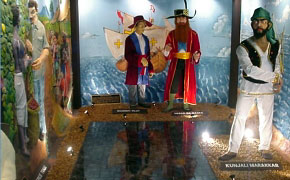
India is reckoned as one of the top ten
naval powers in the world and owes its credit to the dedication and selfless services
rendered by the brave men of India's formidable naval
force.
It is of significance for civilians to understand the
value of existence of such a force, which plays a crucial role in
safeguarding territorial waters of India.
The Maritime
Museum, located at INS Dronacharya in Kochi throws light on the genesis,
history, evolution and landmarks of the Indian Navy.
Step
into the Maritime Museum to have a feel of the great maritime heritage of
Indian Navy, which dates back to Indus Valley civilizations; Kerala's trade
links with Arabs, its famous maritime hero Kunjali Marakkar; Influence of
India's maritime power in South East Asia; Colonization of Indian
sub-continent by European powers.
At the museum, the visitors
are enlightened on the evolution of the navy since 1612, when the Indian
Marine was established in Surat.
A section of the
museum presents interesting aspects of shipbuilding activities in India. It
unravels India's prowess in shipbuilding, which took its culture to the
shores of Java, Sumatra and Bali between 3rd century BC and 12th century
AD.
The museum also has a section, which highlights Indian
Navy's share of glory, when it took on its aggressors and eventually
emerged victorious in the end. These include details of Junaghad operation,
the Goa liberation, Indo-Pak conflicts of 1965 and 1971, Operation Cactus,
Operation Pawan and the strategic maneuvers during
Kargil.
Visiting time: 9:30 am to 1.00 pm and 2.00 pm
to 6.00 pm
Getting there: The Museum is located on the
beach road about 1 km South of St.Francis Church in Fort
Kochi.
Nearest railway station:
Ernakulam, about
15 km.
Nearest airport:
Cochin International Airport,
about 20 km from Ernakulam City. |
| Hill Palace Museum, Thripunithura |
|
 |
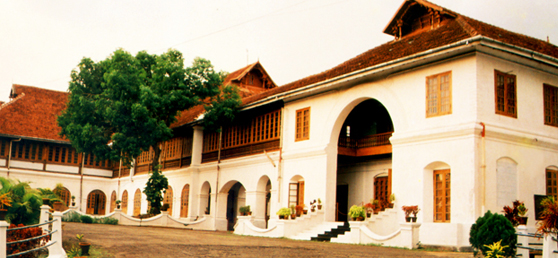
Location: 10 km from Ernakulam
town, Central Kerala.
Visiting hours: 9.00 to
12.30 hrs
and 14.00 to 16.30 hrs
on all days
except Mondays.
Highlights: Kerala's first heritage museum noted for royal collections of the erstwhile Maharaja of Kochi.
The Hill Palace, the
official residence
of the Kochi royal family, is today the largest
archaeological
museum in Kerala. Built in 1865, the palace complex
consists of
49 buildings in the trational architectural style of Kerala,
sprawled over 52 acres of beautifully landscaped terraced land which
houses a deer park and facilities for horse riding. Numerous species
of
flora including rare medicinal plants grow here. On display in
the
full-fledged Ethno-archaeological museum are oil-paintings,
murals,
sculptures in stone and manuscripts, inscriptions, coins,
belongings of
the Kochi royal family and royal furniture
including the simhasana
(throne).
Also exhibited are over
200 antique pieces of pottery and ceramic vases from Japan and
China,
Kudakkallu (tomb stone), Thoppikkallu (hood stone),
menhirs, granite,
laterite memorials, rock-cut weapons from the
Stone Age, wooden temple
models, plaster cast models of objects
from Mohenjodaro and Harappa of
the Indus Valley Civilisation.
The museum also houses a gallery of
contemporary
art.
Getting there:
Nearest railway
station: Ernakulam, about 10 km.
Nearest airport: Cochin International Airport, about 30 km.
|
|
| Madhavan Nayar Foundation |
|
 |
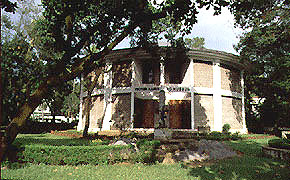
Location
: Just
8
km from Ernakulam town at Edappally,
Ernakulam
district, central Kerala.
Timings: 10:00 - 17:00 hours
on all
days except Mondays.
Attractions :
Showcases the historic events and arts of Kerala.
Located a little
distance
from the crowded urban centre of Ernakulam is a quiet
ethnic building
hidden in the shades of huge trees. A statue of
Parasurama, the sage who
is said to have created Kerala, greets the
visitor. This is a monument to
the history of Kerala and homage to
its makers. The Madhavan Nayar
Foundation also called the Museum of
Kerala History and its makers
showcases historic episodes from the
neolithic to the modern era through
life size
figures.
Light
n sound shows are regularly organised with
commentaries in
English and Malayalam. There is also a gallery for
paintings and
sculptures, displaying over 200 original works by
contemporary
Indian artists.
The
Centre for Visual Arts here has a collection of the
authentic
reproduction of select world masters and larger than life mural
reproductions of Indian art.
Getting there:
Nearest railway station : Ernakulam, about 8
km from
Edappaly.
Nearest airport : Cochin International
Airport, about 20 km from Ernakulam
city. |
|
| Archaeological Museum |
|
 |
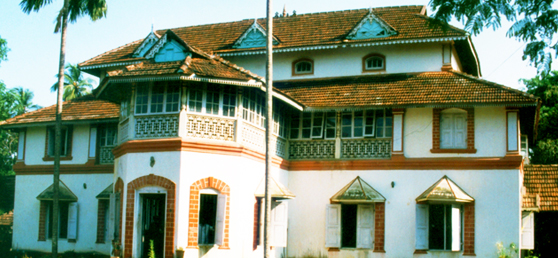
Location: Near the Thrissur Zoo, 2 km from Thrissur town, Central Kerala.
Visiting hours: 10:00 am to 5:00 pm on all days except Mondays and national holidays.
The Archaeological Museum was until recently accommodated in
the Thrissur Town Hall building. Now it has been shifted to
the Kollengode Palace, an architectural delight. The majestic
building houses a gallery of murals from all over Kerala and
preserves a rare treasure of Veerakallu, temple models, olagrandhangal (manuscripts on dry palm leaves), megaliths etc.
Veerakallu
or herostones are stone engravings and sculptures of figures and
weapons belonging to the heroes of days gone by. Most of these
were recovered from the forests of Wayanad and Thrissur.
The
megalith collection includes earthen pots, urns etc. The
temple models cast in plaster of Paris are excellent
representations of the ancient temples in the State.
Getting there:
Nearest railway station: Thrissur.
Nearest airport: Cochin International Airport, about 58 km to the South. |
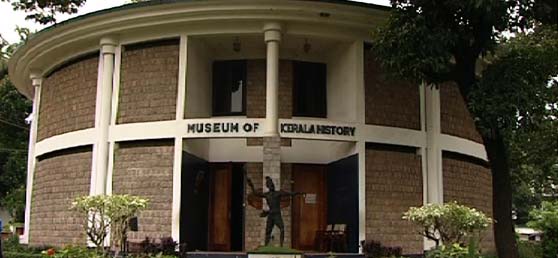
One
picture can say what a thousand words
cannot!
That being the case, without further ado, we
recommend that you pay
a visit to The Museum of Kerala
History in Edapally, Kochi. And once
you are on the lush
grounds of the museum, head straight to the MNF
Gallery of
Paintings and Sculptures and the Centre for Visual Arts.
The
unassuming gallery houses immortal creations that will give you
glimpses of the glorious history and rich cultural legacy of this
land. Some of the masters whose works are on display include mural
maestro Mammiyoor Krishhan Kutty Nair, Raja Ravi Varma, M. F.
Hussain,
folk painter Jamini Roy, abstract painter Manu
Parekh and so on.
Open
from 10 am to
5 pm on all days except Mondays and public holidays.
Getting
there:
By
road: At Edapally,
10 km North of Ernakulam
city
on NH 47.
|
| Indo-Portuguese Museum |
|
 |
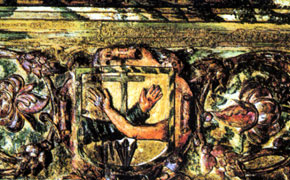
The Indo-Portuguese
Museum situated in Fort Kochi throws light on the strong Portuguese
influence in both the art and the architecture of the
region.
The museum today is an important center for understanding
the Indo-Portuguese Christian Art heritage, which is still surviving. The
museum is the outcome of the untiring efforts of the late Dr. Joseph
Kureethra, Bishop of Kochi. Driven by sheer commitment to protect the rich
heritage
of his Diocese, the bishop established the Indo-Portuguese
Museum to preserve some of the invaluable collections for
posterity.
The museum is divided into five main sections,
according to the nature of items displayed. They are - Altar, Treasure, Procession, Civil Life and Cathedral.
The
museum currently houses some outstanding collections and is well known for its
artistic and architectural marvels, which bear the mark of strong Portuguese
influence. Some of these include a piece of the altar made in teak wood
(16th century) from the Church of Our Lady of Hope, Vypeen, a chasuble (19th
century) from Bishop's House, Fort Kochi, Processional cross, which is a
combination of silver and wood (17th century) from Santa Cruz Cathedral,
Fort Kochi, Indo-Portuguese Monstrance (18-19th century), from The Church of Our
Lady of Hope, Vypeen. Among the displayed items, the Coat of Arms of the
Franciscans needs special mention
The Calouste
Gulbenkian Foundation has also contributed to the rich collection at the
Indo-Portuguese Museum and these include sculptures, precious metal
objects and vestments, among others from the Cathedral of Santa Cruz and
other churches of the Kochi diocese.
The Indo-Portuguese
Museum in Kochi is indeed one of those symbols in the annals of Kochi,
bearing the rich heritage of Indo-Portuguese culture and
artistic
influence.
Address:
Bishop's
House
Fort Kochi
Kerala- 682001
Tel: +91-484-215400 /
215401
Working Hours: 10 a.m. to 5 p.m. Closed
on Mondays and all Public Holidays.
Entry is free on 1st Thursday of
every month.
|
| Teak Museum, Nilambur |
|
 |
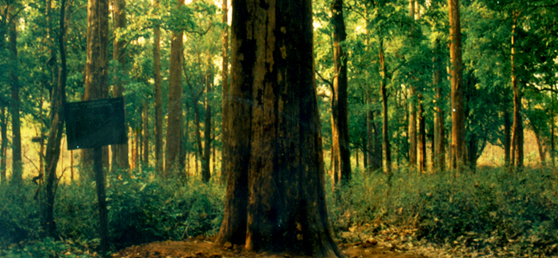
If you are a nature
enthusiast who is desperately pouring your head over volumes to get your
much-needed information on Teak, the wonder tree, then the world famous Teak
Museum
at Nilambur is just the perfect place for you to be in. Here, you
can satisfy yourself with loads of information on this magical bounty of
nature.
The well-known Teak Museum is located at Nilambur in the Malappuram
district of Kerala. Regarded as the first of its kind in the world and
the only one in India; it is a house to the treasures of historical,
aesthetic and scientific aspects of Teak. The museum was established on
the campus of the sub-centre of Kerala Forest Research Institute (KFRI)
in 1995. The museum was established here owing to the historical
significance of the region. The world's first Teak (Tectona grandis)
plantation was raised in Nilambur way back in the 1840s in order to
ensure a steady supply of Teak timber to the British.
The
fascinating abundance of information on this wonder tree attracts an entire
horde of tourists to visit this museum throughout the year. The extensive
root system of a 55-year-old teak tree exhibited in the portico for
welcoming the tourists is itself metaphorical of the past, present and
future of the museum.
The ground floor of the double-storied
museum exhibits a translite of Kannimara
Teak, the oldest naturally
growing teak tree located at the Parambikulam wild-life sanctuary and the
life-size replica of the trunk of the largest known teak tree growing in the
Malayattoor forest division. Another translite of a giant tree present in
the oldest teak plantation in the
Conolly's Plot at Nilambur offers the
visitors a glimpse into the teak plantation activities undertaken 160 years
ago. Some of the other other attractions here are the traditional granary and a
miniature model of sailing vessel called Uru made of teak
wood.
Teak poles of varying sizes and qualities obtained
during the process of
'Thinning' of teak plantations are also displayed
along with the necessary details of standard classification of teak poles.
The depiction of foliage, flowers, fruits and bark of the tree gives us a
deeper insight in to the other characteristics of the teak. Here, one can
also find the large stump of a 480-year-old teak tree brought from
Nagarampara forest range in Kottayam division.
Detailed
description on the flower, fruit and natural regeneration of teak as well as
the prominent characteristics of these species of trees are exhibited in the
first floor of the museum. In addition to this, the various methods of
seed-grading, presowing treatment, preparation of teak stumps, vegetative
propagation of teak and the different stages in the complete rotation cycle
of teak from seed to mature tree are also on display.
Apart from teak, the mueusm also has a collection of over 300 butterflies,
moths and insects found in teak plantations. Another exclusive section in the museum deals
with the various physical disorders of teak, disease-causing insects and
pests, plantation and other nursery diseases.
Some of the special attractions of the Teak Museum at Nilambur are a
series of interesting paintings portraying tree felling operations, a
collection of photographs on the phonological events of teak at
different seasons, exhibits on traditional harvesting tools and wood
samples of different ages from various parts of the world.
The portraits of great figures who had carved out milestones in the
successful establishment of teak plantations as well as of those who
had laid the foundations to the plantation forestry in India like
H.V.Conolly, Chathu Menon and T.F.Bourdillion offer a strong
perspective of a glorious era spanning a period of 150 years. This
museum also has a world-class library on teak and a mini auditorium for
audio-visual presentations.
The 800-metre long bio-resources nature trail
on the museum campus is indeed, an interesting one. This nature trail
passes through a heavy growth of shrubs, trees and bamboos. One can also
find the different species of birds and reptiles here. There are 50
naturally grown tree species and 136 endangered and near-extinct tree
species of the Western Ghats planted in this nature trail. About 58 species
of birds, both resident and migratory, has been recorded in this area. A
medicinal plant garden consisting of 150 species is also another attraction
worth seeing.
Getting there:
Nearest railway
station: Nilambur, about 3 km from the Teak Museum.
Nearest
airport: Karipur International Airport, about 36 km from
Malappuram.
|
| Tea Museum |
|
 |
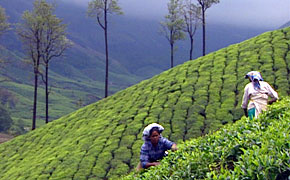
Munnar is perhaps the
choicest of places to preserve and showcase some of the exquisite and
interesting aspects on the genesis and growth of tea plantations
in
Kerala's high ranges. With special emphasis to Munnar, and to the
delight of tea lovers and tourists, Tata Tea recently opened a Tea Museum
which houses curious, photographs and machineries, each depicting a turning
point that contributed to a flourishing tea industry, as seen today in the
region.
The museum set up at the Nallathanni Estate of Tata
Tea in Munnar is a fitting tribute to the toils and rigours of its pioneers,
who showed utmost determination and were resolute in their efforts to
transform Munnar into a major plantation centre of
Kerala.
The Tata Tea Museum diligently portrays the growth of
Munnar tea estates, veritably conveyed through some of the displays like the
rudimentary tea roller to the modern fully automated tea factory. Visitors
to the museum can satiate their curiosity on various stages of tea
processing, and also learn a thing or two about the production of black
tea.
A sundial, placed on a granite block, which was made in
1913 by the Art Industrial School at Nazareth, Tamil Nadu, greets a visitor
to the Tea Museum. At the museum, if one is curious to locate an item with
some antiquity, then the burial urn from the second century BC, which was
found near Periakanal estate tops the list.
Some of the
attention grabbing items on display at the Tea museum include the original tea
roller, the
'Rotorvane,' dating back to 1905, used for CTC type tea
processing; the 'Pelton
Wheel' used in the power generation plant that
existed in the Kanniamallay estate in the 1920s; a rail engine wheel of the
Kundale Valley Light Railway that shuttled men and material between Munnar
and Top Station during the first half of the last century.
A
section of the Tea museum also houses classic bungalow furniture, typewriters,
wooden bathtub, magneto phone, iron oven, manual calculators and EPABX of
the1909 telephone system.
A demonstration room for tea
tasting is another attraction where one would come across different
varieties of tea. Those eager to understand the nuances of tea processing
can do so at the CTC and orthodox tea-manufacturing unit at the museum. The
museum authorities are also contemplating on the idea of allowing tourists
to pluck tea leaves themselves and have them processed in their
presence.
The Tea Museum by Tata Tea would soon become yet another reason for travelers to visit
the enchanting hills of Munnar, which has already become one of the
prime tourist destinations in Kerala.
Timings: 10:00 a.m. to 05:00 p.m. (open 7 days
a week)
Entry Fee:
Adults:
Rs.50
Children below 12 years:
Rs.10
Address:
Tata Tea
Museum
Nalluthanni Estate
Munnar, Idukki
district. |
|









No comments:
Post a Comment